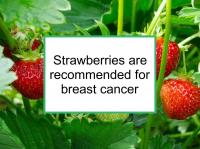Strawberries (Fragaria ananassa) have been shown to have antioxidant, anti-inflammatory, cholesterol-lowering, anti-thrombotic, and neuroprotective properties, and may lower coronary heart disease risk. Strawberries are an excellent dietary source of fisetin and pelargonidin, a very good source of ellagic acid and vitamin C, and also contain some lupeol, manganese, phloretin and resveratrol.
Strawberries and their components have been shown to inhibit proliferation and induce apoptosis of lung, cervical, liver, colon and prostate cancer cells. Strawberries and strawberry extracts have been found to inhibit the development of oral cancer in hamsters and tumor development in the rat esophagus. Consumption of strawberries was found to be associated with lower risk of esophageal cancer in one large U.S. population study. Strawberry consumption has also been found to be associated with reduced risk of head and neck and colorectal cancers.
Breast cancer-related effects of eating strawberries
Berry consumption is associated with reduced breast cancer risk. Strawberries are a source of a variety of compounds with anti-cancer activities, including micronutrients that have been shown to increase the beneficial effects of breast cancer treatment.
Strawberry extract
Numerous studies have found that strawberry extracts inhibit the growth and proliferation of hormone receptor positive (ER+/PR+), HER2 overexpressing (HER2+) and triple negative (ER-/PR-/HER2-) breast cancer cells.
Studies have also reported that mice fed strawberry extract-enriched diets have lower tumor growth than mice fed a control diet in experimental models of triple negative and HER2+ breast cancer.
Fisetin
The strawberry favonol fisetin has been demonstrated to inhibit the growth and migration of triple negative breast cancer cells, thus helping prevent metastasis. Fisetin has also been reported to induce programmed cell death in ER+/PR+ breast cancer cells while not harming normal breast cells. In addition, fisetin has been shown to inhibit the formation of a carcinogenic compound from estradiol (E2), the most important estrogen.
Pelargonidin
Strawberries are a significant source of the anthocyanin pelargonidin, which is not well studied with respect to breast cancer. However, pelargonidin has been shown inhibit the growth of ER+/PR+ breast cancer cells.
More than 25 different anthocyanins have been found in strawberries. However, the anthocyanin content of more richly colored berries such as blueberries and raspberries is far higher than that of strawberries.
Ellagic acid
Ellagic acid, also found in strawberries, has also been shown to reduce the proliferation of ER+/PR+ breast cancer cells and to be effective in the prevention of estrogen-induced mammary tumors in rats.
In fact, ellagic acid has been shown to inhibit breast cancer in a variety of cell and animal studies, in part by inhibiting angiogenesis. Cancer cells induce angiogenesis during the early stages of tumor development — it is a crucial step that separates preinvasive and dormant forms of cancer from invasive and metastatic malignant growth.
Ellagic acid has also been found to increase the sensitivity of ER+/PR+ breast cancer cells to radiation while reducing damage to normal cells, thereby potentially enhancing the treatment effects of radiotherapy.
Additional comments
Non-organic strawberries must be washed very thoroughly to remove pesticide residue as much as possible. Both wild strawberries (Fragaria vesca) and organic strawberries have been found to have higher total phytochemical content and antioxidant capacity than common strawberries.
Below are links to recent studies concerning this food and its components. For a more complete list, including less recent studies, please click on strawberries.
